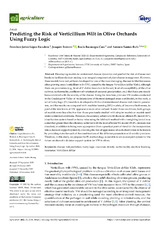Mostrar el registro sencillo del ítem
Predicting the risk of verticillium wilt in olive orchards using fuzzy logic
| dc.contributor.author | López Escudero, Francisco Javier | |
| dc.contributor.author | Romero, Joaquín | |
| dc.contributor.author | Bocanegra-Caro, Rocío | |
| dc.contributor.author | Santos-Rufo, Antonio | |
| dc.date.accessioned | 2023-11-16T10:25:50Z | |
| dc.date.available | 2023-11-16T10:25:50Z | |
| dc.date.issued | 2023 | |
| dc.identifier.issn | 2077-0472 | |
| dc.identifier.uri | http://hdl.handle.net/10396/26217 | |
| dc.description.abstract | Developing models to understand disease dynamics and predict the risk of disease outbreaks to facilitate decision making is an integral component of plant disease management. However, these models have not yet been developed for one of the most damaging diseases in Mediterranean olive-growing areas (verticillium wilt (VW), caused by the fungus Verticillium dahliae Kleb.), although there are parameters (e.g., level of V. dahliae inoculum in the soil, level of susceptibility of the olive cultivar, isothermality, coefficient of variation of seasonal precipitation, etc.) that have previously been correlated with the severity of the disease. Using the data from previous VW studies conducted in the Guadalquivir Valley of Andalusia (one of the most damaged areas worldwide), in this work, a set of fuzzy logic (FL) models is developed with the aforementioned disease and climatic parameters, and the results are compared with machine learning (ML) models, of known effectiveness, to predict the risk levels of VW appearance in an olive orchard. Under these conditions, both groups of models were less effective than those previously studied with simpler models or models used under controlled conditions. However, the accuracy achieved with the most efficient FL model (60%; classification system based on fuzzy rules using the Ishibuchi method with a weighting factor) was somewhat greater than the efficiency achieved with the most efficient ML model (59.0%; decision tree classifier), in addition to being more appropriate (from a practical point of view) for the incorporation into a decision support system by allowing the risk of appearance of each observation to be known by providing rules for each of the combinations of the different parameters with similar precision. Therefore, in this study, we propose the FL methodology as suitable to act as an expert system for the future creation of a decision support system for VW in olives. | es_ES |
| dc.format.mimetype | application/pdf | es_ES |
| dc.language.iso | eng | es_ES |
| dc.publisher | MDPI | es_ES |
| dc.rights | https://creativecommons.org/licenses/by/4.0/ | es_ES |
| dc.source | Agriculture, 13(11), 2136 (2023) | es_ES |
| dc.subject | Disease risk prediction | es_ES |
| dc.subject | Fuzzy logic | es_ES |
| dc.subject | Inoculum density | es_ES |
| dc.subject | Isothermality | es_ES |
| dc.subject | Machine learning | es_ES |
| dc.subject | Resistance | es_ES |
| dc.subject | Verticillium dahliae | es_ES |
| dc.title | Predicting the risk of verticillium wilt in olive orchards using fuzzy logic | es_ES |
| dc.type | info:eu-repo/semantics/article | es_ES |
| dc.relation.publisherversion | https://doi.org/10.3390/agriculture13112136 | es_ES |
| dc.rights.accessRights | info:eu-repo/semantics/openAccess | es_ES |

